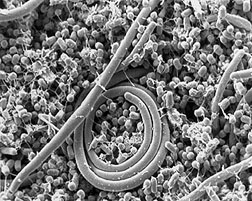This page has been archived and is being provided for reference purposes only. The page is no longer being updated, and therefore, links on the page may be invalid.
Read the magazine story to find out more. |
|
DNA Chips Spot, Help Track Antibiotic Resistance
By Sharon DurhamNovember 9, 2005
A genetic chip that detects more than 100 antimicrobial-resistance genes in bacteria has been developed by Agricultural Research Service (ARS) scientists in Georgia.
The DNA chip, called a DNA microarray, is a small glass slide that allows researchers to determine the presence or absence of particular DNA sequences in a sample.
ARS microbiologists Jonathan Frye, Charlene Jackson, Mark Englen and Paula Cray developed the DNA microarray to detect genes that make bacteria resistant to antibiotics. The scientists are based at the ARS Bacterial Epidemiology and Antimicrobial Resistance Unit in Athens, Ga.
Antimicrobial compounds, or antibiotics, have been used for years to fight bacterial infections. But some bacterial pathogens, like Salmonella and Campylobacter, and other intestinal bacteria, like Escherichia coli and Enterococcus, are becoming resistant to antibiotics.
Unfortunately, under the right conditions, DNA that's linked to resistance may be exchanged between bacteria--including those bacteria responsible for animal and human infections--when they come together. Scientists need to know which bacteria are resistant to antibiotics and how bacteria continue to develop resistance to new antibiotics.
The researchers use the microarrays to track resistant genes in bacteria from farm and slaughter facility samples. According to Frye, this information will help identify possible points to target for intervention strategies to prevent the development and spread of resistance.
Read more about the research in the November 2005 issue of Agricultural Research magazine.
ARS is the U.S. Department of Agriculture's chief in-house scientific research agency.

